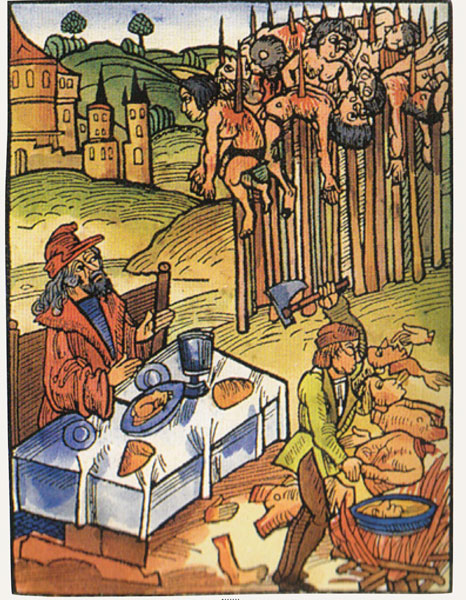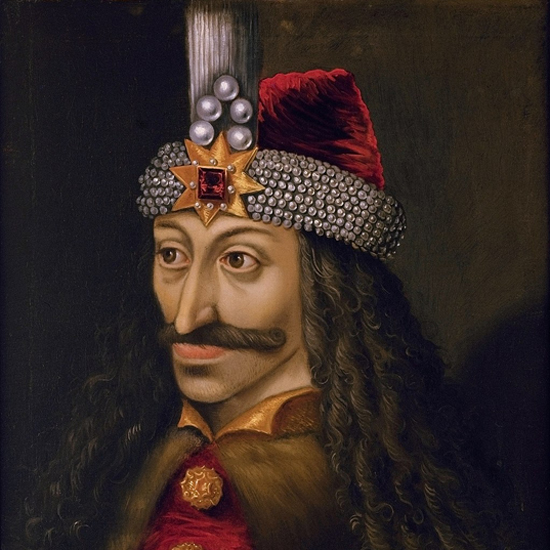
Regional introduction
Vlad the Impaler, his full name Vlad III Dracula, also known as Vlad Țepeș . Historical facts, and not based upon the Dracula, Prince of Many Faces: His Life and His Times Paperback – Illustrated, Oct. 31 1990 by Raymond T. McNally (Author), Radu R Florescu (Author) fiction. For those who lack historical knowledge of Central European history in the 14th and 15th Century, this book is an interesting book to read, as long as they do not fall into the trap the authors conceived in their false national grandeur.
Reality vs fiction
This book has several flaws big enough to drive a Dacia through it and would take a lot of pages, if not another book to correct all of them. A Dacia, for those who do not know, is a Romanian built automobile, based upon an out-dated Renault 12, design that was manufactured in the 1970’s during Communist times. It was considered to be crap mobile! Since then the Dacia brand improved a lot.
Fascinating how historical facts intermixed with obvious bias, envious bitterness and written with, in my opinion, a chip on their shoulder, includes inadequacies lacking a national historical identity towards the true owners and rulers of the Erdély, the region known in Latin as Transylvania, “beyond the forest,” can portray a Wallachian despot, a Prince wannabe named Vlad III, better know as Dracula, as a national hero! No wonder the same people who call Dracula their national hero in the 20th century, who’ve uprooted 1000 year old villages, bulldozed down every house and all monuments, justifying their actions in the name of ethnic cleansing; then, resettled tens of thousands of persons from Hungarian speaking areas in Transylvania into harsh regions of modern Romania, Yes, that would make Dracula proud!
Historical facts about Transylvania
While there is a lot of history portrayed in this book, it is done with much envy and distortion towards Hungarians in general. Right from the beginning of the book “…Transylvanian place names that have Romanian, German, and Hungarian equivalents, we shall use the modern Romanian names…” This only makes sense one would assume, however even such simple statements reflect the falseness that is displayed throughout the book. It is implying that the Hungarian names held the least or were of no significance in the history of Transylvania, where as, the truth is factually the opposite. In Dracula’s era, there was no such country as Romania, nor was Romanian an official language in Transylvania. The official language was Hungarian, Latin used for general administration, German in the Saxon cities, while Romanian was spoken by the minority in the western counties or duchies, increasing towards majority near the bordering counties or duchies that were near the regions of Wallachia and Moldavia. Romanian names in Transylvania only became dominant after 1918. Since the events portrayed in this book took place mostly in the 1400’s to be historically accurate, and unbiased, one should use the proper names perhaps with the modern names in brackets for reference to their location in modern Romania. The method used in the book is just an extension of the eradication and continued denial of the significant Hungarian culture, history or presence in the region.
Transylvanian history goes back to time of the Roman Empire, as it was an outpost region bordered within the western slopes of the Carpathian mountain range known as Dacia. In brief, as the Roman Empire broke up and separated into separate two Empires: Western and Eastern, ethnic tribes from the East started to migrate into areas formerly occupied by the Romans. These invaders such as the Huns, Avars, Lombards, Gepids, Slavs, and later the Magyar tribes, moved into the Carpathian basin and the surrounding areas just west of the Byzantine Empire. Some have left and moved on. These eastern invaders conquered, subjugated the native population, some who intermarried with descendants of the original Roman Legionaries who decided to stay behind once the empire fell apart, thus forming the native population for the next generations. The Carpathian basin including the regions of Pannonia and Dacia of the former Roman Empire were settled by the Ten Magyar, (Hungarian) tribes. Thus, the Magyar (Hungarian) State was established in 896 AD. Note at this time, and for almost 1000 years after the establishment of Hungary, there was no Romania. The modern state of Romania was formed by the merging of the Danubian Principalities of Moldavia and Wallachia in 1859 and in 1918 Hungarian Transylvania was annexed by the victors of WWI, as punishment for the Hungarian participation in WWI. When the pagan Hungarian King Vajk, converted to Christianity and adopted the Christian name István, (Stephen, who later was named a Saint), and by force converted the rest of the Magyar pagans, he was rewarded by the Pope in Rome and by Byzantine Emperor with crowns to symbolize his sovereignty over the lands under his command including Transylvania. The two crows were assembled into one as the Holly Crown of Hungary. As the Hungarian kingdom congealed, and needed additional populous at the eastern borders (Transylvania) to shore up the defences against any further invasions from the East, such as the Hordes of Genghis Khan, and the Ottoman Turks, Székely (Szeklers descendants of the Huns, who left after the death of Attila) from the East and Saxon (German) settlers from western Europe were encouraged to move in, along with the Teutonic Knights (who were expelled later on), and were granted lands and independent city statues, but were subject to the Crown of Hungary.
The falsification of history
Wallachia east and Moldavia to the north of Transylvania were autonomous regions ruled by Princes, or pretenders to the throne. These regions were populated in majority by Romanian speaking inhabitants.
Thus, what these so called historians scholars have cooked up about a petty Wallachian despot named Dracula, as the founding father of Romania, is a laughable! “Dracula became a national hero par excellence, one who defended the nation’s independence against overwhelming odds – kind of George Washington of the Romanian people…” I do not believe George Washington had people impaled while he ate his dinner, nor had tens of thousands (if not over a hundred thousand) killed by boiling, skinning people alive, sawing off their limbs, who’d disagreed or challenged his political ambitions. Nor was Dracula like Robin Hood, giving to the poor from the rich!
Throughout the book, and at every opportunity, the Hungarians are perceived as corrupt, unreliable, who had betrayed Vlad III, spreading false propaganda unjustly, undeservingly about this Christian Knight, who wore the Order of the Dragon.
John Hunyadi, and the King of Hungary
John Hunyadi, (being described as: from a humble Wallachian stock, a turncoat Hungarian wannabe), he actually was a true Christian Crusader at the time and whose victory over the Turks in 1456 at Belgrade is still celebrated to date: every day at noon, when church bells are rung. Hunyadi was the Regent of Hungary and the Governor of Transylvania, his son King Matthias Corvinus, was described as “…King Matthias evidently liked to think of himself as a true patron of learning and the arts.” Matthias didn’t have to think of it, he was!
Matthias established the flowering culture of the Hungarian Renaissance, by modernizing and building. His treasures were ransacked by the Turks later on, but some of the surviving books that were published upon his orders and were housed in the King’s Library the Corvinus Codex’s are worth millions and are now treasured by Museums world wide. In fact, the only painting of Dracula that existed was done by the King’s artist while
Dracula imprisoned
Dracula was in his imprisonment, when the King had no choice but to put Dracula in “prison” for his alleged autocracies after Vlad III, was overthrown the second time by his rivals.
However, the prison was far from a real prison, it was more like a house arrest and at the Salamon Tower of the Visegrád Castle, near the King’s palace.I do not know of many prisoners in history who were allowed to marry the cousin of the King, while being incarcerated by the same King. The fact is that Vlad III, aka Dracula, married his second wife Ilona Szilágyi, aka Jusztina Szilágyi, a cousin of the King, while he was in, so called “imprisoned”. His first wife may have been an illegitimate daughter of John Hunyadi, the King’s father, according to historian Alexandru Simon. Vlad III was released at the request of Stephen III of Moldavia in the summer of 1475. He fought in King’s army against the Ottomans in Bosnia in early 1476. Dracula was put back in power for the third time to help with the continued fight and gain a psychological advantage against the invading Ottomans. Dracula’s fierce reputation against the Turks gained by his prior autocracies against them and excellent knowledge of their tactics was something that the King did not ignore.
Just a Warlord
The real Dracula, Vlad III, was not a forthright Christian or a nationalist hero. At the very best, he was a warlord with many ambitions. He was power hungry, cruel, sadistic, evil, revengeful, and treacherous yet, a very savvy individual who made the right connections with powerful benefactors, looking out for his own true interests in being or trying to be the ruler of Wallachia. Ambitions supported by using all his talents and available methods: torture, intimidation, bribery, and psychological warfare against not just his enemies but his own subjects. While Dracula did fight the Ottoman Turks, it was based upon his childhood hate towards the Turks (for that Dracula cannot be blamed, he was the Sultan’s hostage in Constantinople, and more than likely was sexually molested while in his Court). In addition his own self interests in manifestation of power to rule independently over Wallachia against Ottoman expansionism, by being a Christian Crusader. Dracula was in many ways just like many of his contemporary power hungry despots and tyrants in the 14th to the 15th centuries who made deals and alliances with more powerful benefactors. What made him different was that he was a lot more cruel and bloody in his methods. By constructing monasteries he thought he could seek salvation from eternal damnation and from hell.

Death of Dracula
Ironically in 1476, when Dracula was assassinated, his head was cut off and taken to Constantinople to the Sultan to be displayed on a pole, just like he had done to so many of his enemies. If not for Bram Stoker, Dracula would have been forgotten in history, like so many petty tyrants of the era.
By the way, it is only a myth that Bran Castle (Bran Castle (Romanian: Castelul Bran; German: Schloss Bran; Hungarian: Törcsvári kastély) is Dracula’s castle. Bran, 25 kilometres (16 mi) southwest of Brașov, Romania. His real castle was Poenari Castle Cetatea Poenari in Romanian), is a ruined castle which was a home of Vlad the Impaler. The castle is located on the plateau of Mount Cetatea, facing the west side of the Transfăgărășan, on a canyon formed on the Argeș River valley, close to the Făgăraș Mountains. The castle is situated high atop a mountain and accessed by climbing 1,480 concrete stairs.





